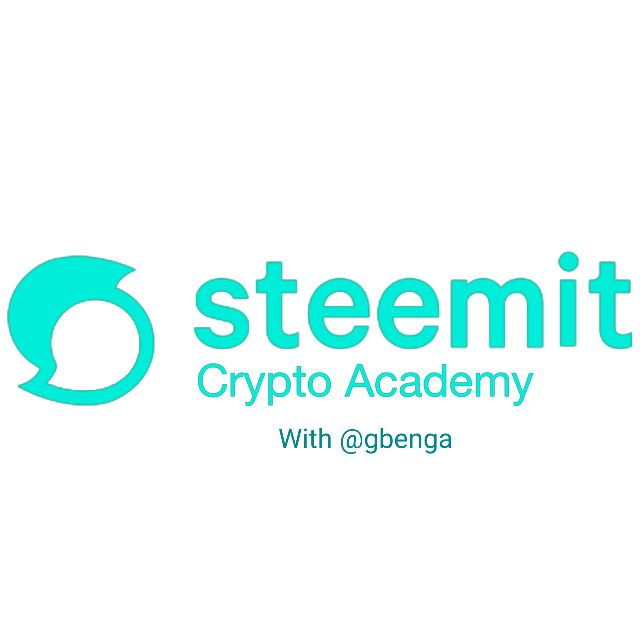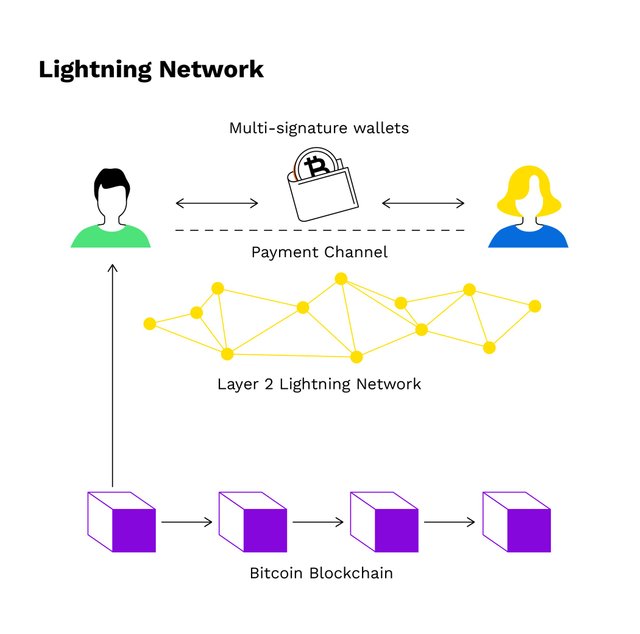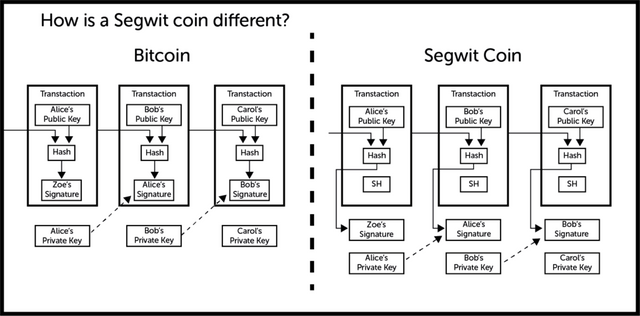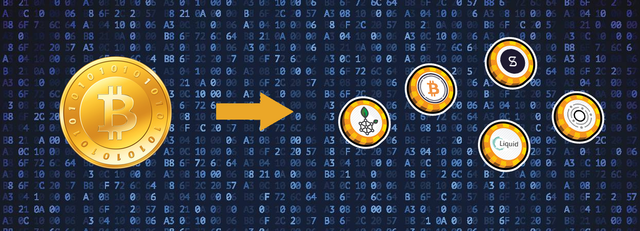The Steemit Crypto Academy Week 3: All You Need to Know About Bitcoin Network

Course Outline
Introduction
Bitcoin of Speed
What is Bitcoin (A Summary)
Bitcoin Scalability
Bitcoin Lightning Network
Segregated Witness (Segwit)
Benefit of Segwit
Legacy, Native Segwit, and Nested Segwit Bitcoin Network
Tokenized Bitcoin
Why use Tokenized Bitcoin
Problems Tokenized Bitcoin is Solving
Conclusion
Task
Image Source

Introduction
It is an honor to be here again as your steemit crypto professor and I want to use this opportunity to welcome you to the third lecture of the steemit crypto academy and I hope you enjoy the lecture. If you missed my previous classes, I will be leaving the links at the end of this publication.
In this course, I will be taking a deep look into Bitcoin, its speed, forks, tokenized Bitcoin, and many more. I will try to my ability to simplify everything in this post and make you enjoy and understand every bit of the lecture. With this said, let the class begin.

Bitcoin of Speed
What is Bitcoin (A Summary)
Bitcoin isn't a new name to so many people both in the industry and outside the industry, as you must have heard your next-door neighbor saying they want to buy Bitcoin.
So What is Bitcoin?
Bitcoin is regarded as digital cash (cryptocurrency), stored in public decentralized ledgers built on an open-source blockchain. Transacting Bitcoin is on a peer-to-peer basis with no intermediary making it uncensored and uncontrollable by a central authority. 1 Since Bitcoin is digital, it means there is no physical Bitcoin so every balance and transaction is done on the public ledger (blockchain) which leads to Bitcoin Scalability.
Bitcoin Scalability
Scalability is the ability to handle growth and give results based on demand and for Bitcoin, scalability refers to its ability to handle transactions no matter how large it is. Bitcoin at its initial state looked really good and it could hold up and perform a lot of transactions but as people started looking into Bitcoin and cryptocurrency, it became clear that Bitcoin had a setback (relatively low throughput)2.

The Bitcoin protocol where a block can be generated every 10 minutes with a maximum size of 1 megabyte (proof of work) led to the limitation where Bitcoin blockchain can only hold within 5 to 7 transactions per second 3. The scalability problem of Bitcoin led to its first fork of Bitcoin Cash but then what solutions can be done to make Bitcoin faster?
Bitcoin Lightning Network
Referred to as the Second layer/layer two technology of the Bitcoin chain, first proposed by Joseph Poon and Thaddeus Dryja in the year 2015, aims to increase the speed, numbers of transactions and reduce the cost of transacting on the blockchain without tampering with the blockchain protocol.
lightning network
To do this, transactions done are recorded on another protocol built on the bitcoin blockchain. With this, the Bitcoin blockchain is less congested and transactions can be done near immediately at a very low cost since they are done off the blockchain 4. With the lightning network, transactions are done off-chain between two parties who agree and lock up fundings (BTC) in a multi-signature wallet. The two parties can perform as many transactions as needed on the network and would only release the Bitcoin to the blockchain when they both agree. The transactions done off the chain are referred to as commitment transactions and they only become recorded based on agreement from the parties involved thanks to Smart Contract.
Segregated Witness (Segwit)
Lightning network isn't a solution to the blockchain, rather it is a second layer protocol built on top of the Bitcoin network but Segwit was a better solution on the blockchain. With Segregated Witness (Segwit), the size of the block is increased as digital signatures are segregated from the transaction data.
In 2015, Dr. Pieter Wuille proposed that instead of every input and output transaction data of Bitcoin being signed by witnesses thereby taking about 65% of a block, why not segregate the witness signatures from the transaction data/block thereby increasing the blocksize for transactions from 1 megabyte to 4 megabytes?
This proposal was taken into action in a soft fork in 2017 and currently, virtually every blockchain uses Segwit. Segwit doesn't increase the block size but rather separates signatures of witnesses from every transaction data thereby increasing the number of transaction data that can be handled by an effective block 5.
segwit and non-segwit block
Segwit was implemented with a soft fork to reduce panic and give miners a choice to pick and as such, not everyone can be a part of it and it can be reversed. Both Segwit and Non-Segwit nodes are compatible.
Benefit of Segwit
Reduction of Bitcoin network load and Increasing Bitcoin network capacity
Increase in speed of transaction
Transaction malleability fixes thereby reducing fraudulent activities.
Reduced transaction cost
Legacy, Native Segwit and Nested Segwit Bitcoin Network
Legacy Bitcoin Network
This was the original Bitcoin network as it was in 2009, this is the address without the fork. This address is supported by all exchanges and wallets since it is the initial address to be created. transactions are slower with the Legacy Bitcoin network. The addresses on this network can be identified as they start with "1"
Nested Segwit Bitcoin Network
This was the first upgrade/fork made on the Bitcoin network where witness signatures were separated from the block making the network faster and allowing it to hold more transactions up to 4MB. The fees for Nested Segwit is lower than Legacy Bitcoin network and its address can be identified as it starts with "3"
Native Segwit Bitcoin Network
This is the upgraded version of the Nested Gegwit which allows for lower transaction fees and faster transaction speed. The address is identified by lower case letters and it starts with "bc1" 6.
Tokenized Bitcoin
Tokenization refers to the representation of a coin on a blockchain that isn't its native blockchain. With this, Tokenized Bitcoin is the digital representation of Bitcoin on another blockchain.
This is possible through the locking of Bitcoin on another Bitcoin network and minting the tokenized Bitcoin at a ratio of 1:1 on the chain thereby allowing its minted representation of Bitcoin to be transacted on its blockchain at the value of BTC. Examples of tokenized Bitcoin include WBTC, renBTC, sBTC, tBTC, BTCB, iBTC, and so on.
Why use Tokenized Bitcoin
It is no doubt that Bitcoin has been the most established cryptocurrency since its inception and its blockchain is also well known but then, the Bitcoin network has its own limitations which include slow transaction process, block size, and its limitation on smart contracts.
With the tokenization of Bitcoin on other blockchains, the representation of Bitcoin can be sent from one wallet to another on the blockchain faster and several transactions can be done at once also. With Tokenized Bitcoin, Decentralized Finance platforms have been able to utilize Bitcoin faster and more scalable, also, It has also increased the utility of Defi on other blockchain networks. The importance of tokenizing Bitcoin is to improve interoperability between Bitcoin and any other blockchain especially the Ethereum Blockchain.
Problems Tokenized Bitcoin is Solving
- Liquidity for decentralized exchanges and Decentralized Finance platform built on other blockchains.
- Smart contracts and dApps on other blockchains can now use a representation of BTC effectively.
- Faster confirmation period when sending from one user to another

Conclusion
Over the years, Bitcoin and its network have evolved and have shown great improvement from the Legacy Bitcoin Network to Segwit Bitcoin Networks. The Segwit fork of bitcoin has been able to solve Bitcoin's biggest problems which include the speed of up to 1 minute and scalability. Also, the Lightning network protocol built on the bitcoin blockchain has allowed for a larger number of transactions at a very fast speed and cheap rate.
Also working towards integrating Bitcoin into other blockchains for easy accessibility of BTC and for faster transactions came the Tokenization of Bitcoin which has been adopted by several blockchains such as Ethereum chain, Binance chain, and many other chains.

Task
The Rules
- Everyone is eligible to participate in this task.
- The Post should be a minimum of 300 words and should be submitted in the crypto-academy community for visibility.
- You should include the exclusive tag #steemitcrypto and a tag of your country (for example #nigeria).
- Post should be your original content. Show references for images used when writing your post.
- Task runs until Sunday, February 28th, 2021




@gbenga, Thanks you for the new task. Could you check out my work: https://steemit.com/hive-108451/@vipnata/homework-task-2-ii-will-you-keep-your-crypto-assets-in-a-wallet-or-on-an-exchange-for-gbenga
Excelente post @gbenga, saludos desde #venezuela.
HI @gbenga Thanks a lot for the lesson! here is my homework..
https://steemit.com/hive-108451/@joseantpp/esp-eng-homeworkthe-steemit-crypto-academy-week-3-all-you-need-to-know-about-bitcoin-network
#venezuela #affable
Hello sir @gbenga topic of this week is very interesting as i have also participated in this homework task.
Crypto Academy Week 3 Homework Post for [@gbenga]Segwit Bitcoin Network or Legacy Bitcoin Network, which do you prefer and why?
Check it when you are available.
#affable #pakistan
Thanks for this opportunity ! @gbenga
Hello @gbenga here is my entry post
https://steemit.com/hive-108451/@okoyejoshua/crypto-academy-week-3-homework-by-gbenga-written-by-okoyejoshua
Hello @gbenga here is my entry
https://steemit.com/hive-108451/@simonnwigwe/segwit-bitcoin-network-or-legacy-bitcoin-network-which-do-you-prefer-and-why
This information helps to better understand the blockchain, grateful for your effort friend, greetings and congratulations
hi dear professor here is my task https://steemit.com/hive-108451/@ramsesuchiha/crypto-academy-week-3-homework-post-for-gbenga-bitcoin-network-eng-esp
shared on twitter https://twitter.com/rael56948364/status/1363897821305462784?s=20
Buenas noches Profesor @gbenga. Esta es mi
Tarea # 3